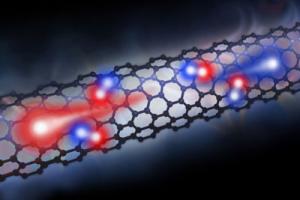Researchers from Cornell have made a simple solar cell (photodiode) made from a single-walled carbon nanotube (a rolled up Graphene layer). The researchers created just one photodiode (one nanotube). They say that this is could lead to extremely efficient solar cells.

The nanotube is about the size of a single DNA molecule. They wired it between two electrical contacts, and close to two electrical gates, one negatively and one positively charged. The narrow, cylindrical structure of the carbon nanotube caused the electrons to be neatly squeezed through one by one. The electrons moving through the nanotube became excited (they used lasers on the nanotube) and created new electrons that continued to flow. The nanotube, they discovered, may be a nearly ideal photovoltaic cell because it allowed electrons to create more electrons by utilizing the spare energy from the light.
This is unlike today's solar cells, in which extra energy is lost in the form of heat, and the cells require constant external cooling.